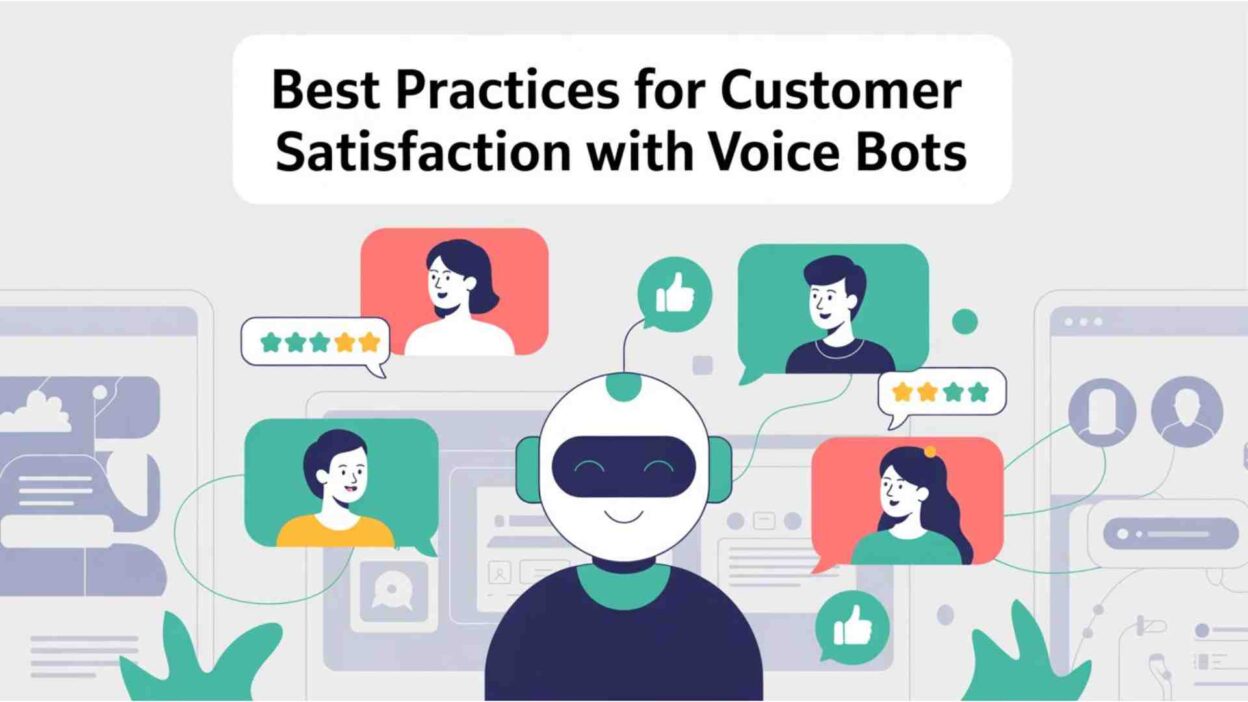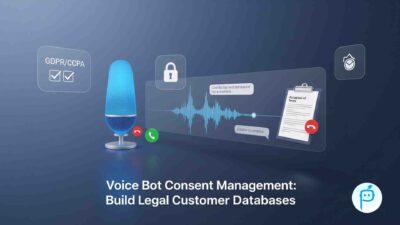How Voice Bot Customer Satisfaction Changed Everything
Voice bots are no longer the enemy of customer service. They have become powerful tools. Modern AI systems can handle complex conversations with remarkable skill.
Table of Contents
Early voice systems frustrated customers with rigid menus. Today’s voice bots understand natural language. They remember previous conversations. They solve problems without human help.
Recent studies show impressive results. 73% of customers report positive experiences with AI-powered voice bots. 65% prefer voice bots for after-hours support. 58% appreciate consistent service quality.
Key Drivers of Voice Bot Customer Satisfaction
Instant Response Times
Customers love immediate answers. Voice bots provide 24/7 availability. No more waiting in long phone queues. No more calling in business hours.
Account inquiries get instant responses. Order status updates happen immediately. Basic troubleshooting starts right away. Appointment scheduling works around the clock.
Consistent Service Quality
Human agents have good days and bad days. Voice bots deliver the same quality every time. They access identical knowledge bases. They follow standardized processes perfectly.
Accurate information gets delivered consistently. Complex procedures execute flawlessly. Emotional neutrality prevents service variations. Compliance requirements get met automatically.
Smart Personalization
Modern voice bots remember customer preferences. They instantly see past interactions, adjust to each person’s communication style, and accurately predict customer needs.
Account recognition happens through voice patterns. Historical context eliminates repeated explanations. Preference learning improves over time. Predictive assistance offers relevant solutions.
Best Practices for Maximum Voice Bot Customer Satisfaction
Design Natural Conversations
Successful voice bots feel like talking to humans. Conversation flows follow natural patterns. Context gets retained throughout interactions. Flexible input handling accommodates different speaking styles.
Interruptions get managed gracefully. Topic changes happen smoothly. Questions get acknowledged appropriately. Transitions feel seamless and natural.
Implement Transparent AI Disclosure
Customers deserve to know they’re talking to AI. Clear disclosure builds trust immediately. Capability explanations set proper expectations. Limitation transparency prevents disappointment.
Human escalation options remain easily accessible. Regulatory compliance gets maintained automatically. Customer trust increases through honest communication.
Focus on Common Use Cases
Voice bots excel at routine inquiries. High-volume requests get handled efficiently. After-hours support covers urgent needs. Initial triage routes customers properly.
Self-service transactions work perfectly. Password resets happen instantly. Address changes get processed quickly. Account management becomes effortless.
AI Call Success Stories Across Industries
AI call success stories will multiply across industries.
Healthcare Appointment Scheduling
A major healthcare network faced 50,000 monthly appointment requests. Limited administrative staff created long wait times. Patient frustration reached critical levels.
Voice bots transformed their scheduling system completely. 85% reduction in wait times occurred immediately. 92% of patients scheduled appointments without human help. 78% satisfaction scores proved customer acceptance.
HIPAA-compliant data handling ensured privacy protection. Multilingual support served diverse populations. Gentle tone programming matched healthcare sensitivity. No-show rates dropped by 40%.
Financial Services Account Management
A regional bank struggled with high call volumes. Routine account inquiries overwhelmed human agents. Complex financial consultations got delayed frequently.
Voice bot implementation delivered impressive results. 67% reduction in human agent calls occurred. 89% customer satisfaction for routine inquiries emerged. Fraud detection improved by 45%.
Robust security protocols protected customer data. Voice authentication prevented unauthorized access. Real-time fraud alerts enhanced security. Annual savings reached $2.3 million.
E-commerce Order Support
An online retailer handled complex post-purchase inquiries. Multiple product categories complicated support processes. Varying return policies confused customers.
Voice bots revolutionized their customer support operations. 73% of order inquiries got resolved automatically. Return processing time dropped by 56%. Customer satisfaction reached 81%.
Real-time inventory integration provided accurate information. Flexible return policies accommodated various scenarios. Proactive order updates improved communication. First-call resolution improved by 38%.
Measuring Voice Bot Performance
Essential Satisfaction Metrics
Net Promoter Scores measure customer loyalty. Customer Effort Scores track ease of use. First Call Resolution rates show effectiveness. Customer retention indicates long-term success.
Task completion rates reveal operational efficiency. Average handling times measure speed. Escalation rates identify improvement areas. Accuracy rates ensure reliable information.
Continuous Improvement Strategies
Monthly performance reviews identify trends. Customer feedback integration provides direct insights. Conversation analysis reveals failure points. A/B testing optimizes different approaches.
Knowledge base updates keep information current. Regular training improves system responses. Feedback loops enable rapid improvements. Data analysis drives strategic decisions.
Common Challenges and Solutions
Handling Complex Queries
Complex requests can overwhelm voice bots. Intelligent complexity detection identifies limitations quickly. Immediate escalation options prevent customer frustration.
Clear communication about capabilities sets expectations. Specialist connections happen seamlessly. Customer satisfaction remains high through proper routing.
Managing Customer Expectations
Realistic expectations prevent disappointment. Clear capability explanations help customers understand. Specific examples demonstrate voice bot strengths. Transparent limitations build trust.
Proper expectation setting improves satisfaction scores. Honest communication increases customer confidence. Realistic promises deliver better experiences.
Dealing with Frustrated Customers
Emotional customers need special handling. Empathy responses acknowledge customer feelings. Quick escalation paths provide immediate relief. Specialist connections offer personal attention.
Emotional intelligence features detect frustration. Appropriate responses calm upset customers. Human specialists handle sensitive situations. Customer satisfaction improves through proper care.
Future Trends in Voice Bot Customer Satisfaction
Emotional Intelligence Integration
Advanced voice bots detect customer emotions. Tone-appropriate responses match customer moods. Proactive empathy addresses frustration immediately. Positive reinforcement celebrates successful interactions.
Communication styles adapt to customer preferences. Emotional state recognition improves responses. Personalized interactions feel more human. Customer satisfaction reaches new heights.
Multi-Modal Integration
Voice interactions combine with visual elements. Mobile apps support complex troubleshooting. Screen sharing enables detailed assistance. Multiple channels provide consistent experiences.
Chat integration offers text alternatives. Email support continues conversations. Social media channels extend reach. Seamless transitions improve customer journeys.
Predictive Customer Service
Voice bots anticipate customer needs proactively. Outreach prevents problems. Personalized recommendations improve experiences. Automatic problem resolution saves time.
Usage patterns predict future needs. Preventive maintenance alerts help customers. Behavioral analysis enables better service. Proactive support increases satisfaction.
Building a Customer-Centric Voice Bot Strategy
Understanding Your Customer Base
Demographic analysis identifies ideal users. Use case mapping reveals common inquiries. Channel preferences guide implementation decisions. Pain point identification targets improvements.
Customer segments require different approaches. Service preferences vary by demographics. Communication styles differ across groups. Understanding drives better solutions.
Designing for Customer Success
User-centric design prioritizes customer goals. Accessibility ensures everyone can participate. Cultural sensitivity respects diverse backgrounds. Continuous evolution meets changing needs.
Customer success drives design decisions. Inclusive interfaces serve all users. Cultural awareness improves acceptance. Adaptive systems grow with customers.
Implementation Best Practices
Phased rollouts minimize risks. Staff training ensures seamless integration. Customer education promotes adoption. Feedback loops enable improvements.
Low-risk use cases prove value. High-value scenarios demonstrate ROI. Gradual expansion builds confidence. Continuous optimization drives success.
Read More: Quantum Voice Processing: Ultra-Fast Response Generation
Conclusion

Voice bot customer satisfaction has reached a tipping point. Customers now prefer AI assistance for many interactions. Thoughtful implementation delivers exceptional results.
The key lies in customer-centric approaches. Transparency builds trust immediately. Accessibility ensures universal participation. Seamless human integration provides backup support.
Organizations investing in customer understanding will succeed. Proper implementation exceeds customer expectations. Continuous optimization drives sustained competitive advantage.
The future belongs to businesses blending AI efficiency with human empathy. Voice bot customer satisfaction will continue improving. Businesses can build voice bots that exceed customer expectations and create positive experiences that boost loyalty and growth in a competitive market.






[…] Read More: Best Practices For Customer Satisfaction With Voice Bots […]
[…] Read More: Best Practices For Customer Satisfaction With Voice Bots […]
[…] Voice bot productivity transforms how businesses allocate human resources for maximum profitability. PreCallAI liberates […]